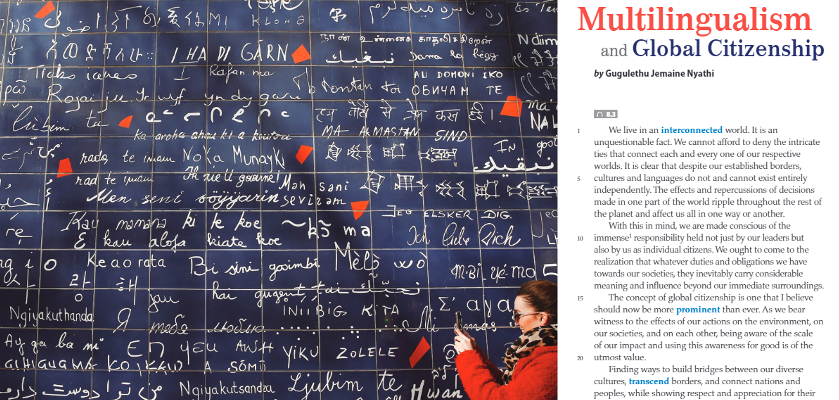The International Baccalaureate (IB) focuses on teaching the value of perspectives, ideas, and connections from around the world. Whether you’re new to the IB, an IB educator, or are familiar with another curriculum framework, you probably know that it’s a challenge to think about how to take a big idea like “International Mindedness,” connect it in an interdisciplinary way, and give students the chance to take action on what they have learned. This blog post intends to demystify some of those challenges using the IB as a reference, encouraging all teachers to think both broadly and practically about the importance of engaging students with these ideas in mind.
What makes National Geographic Learning programs a great fit for the International Baccalaureate Curriculum Framework? Learn more in our brochure, English Programs in Connection to IB World Schools!
International Mindedness
International Mindedness is a foundational concept in the IB. It asks both teachers and students to think about the world in a way that recognizes that there are many ways to get to a conclusion, that there are multiple perspectives that we can draw on when we try to solve problems, and that there are usually many solutions that can work.
In some ways, it’s easier to think of it by reversing the concepts…”mindedness” first, “international” second. Mindedness is the idea of ‘thinking’ — how do we think? How do we come to conclusions? What are our habits of mind? To be internationally minded is to think in a way that allows us to explore possible solutions to different problems from different perspectives.
International Mindedness also celebrates multilingualism, as each language provides a different way of understanding and viewing the world. In some ways, all language acquisition (additional language) classrooms are inherently Internationally Minded because they challenge students to think using multiple perspectives as a result of learning a new way of viewing the world.

The image above from the National Geographic Learning program Lift is an example of this connection. Language learning gives us all the opportunity to understand the world from a new perspective, allowing us to be internationally minded.
Inquiry Questions and Interdisciplinary Instruction
One way to approach international mindedness is through inquiry within and across disciplines. Inquiry provides students and teachers with the opportunity to dive into big questions and to explore them from different perspectives. National Geographic Learning’s Lift program is framed around inquiry questions, and when we examine this program, it’s easy to see how students can get excited about this kind of learning. Here are some examples of inquiry questions:
- What impact can clean water have on the world?
- How can we achieve happiness?
- Why is it important to belong?
Inquiry questions are open-ended, can have multiple answers, and can be approached from a variety of subject areas. They can also be intimidating.
In order to teach effectively in an inquiry styled way, it’s most exciting if we enable students to draw upon all of their learning in all of their subjects. This allows for strong writers to participate in some ways, great scientists to participate in other ways, and for mathematicians and artists to find their way as well. Below is an example of how this inquiry can happen.

This unit from Lift allows students to explore the impact that clean water can have on the world through literature, science, imagery and through stories. Students have the opportunity to dive into the topic, learn perspectives from around the world, and engage in a topic that is current and relevant to their lives.
Service Learning
When students get excited about a topic, they often want to take action, but don’t know how. Embedding a service learning teaching component into the classroom is one way to help students take their excitement and turn it into meaningful action. Teachers are sometimes hesitant about trying to get students to engage in work outside of the classroom for all sorts of legitimate logistical considerations. Students sometimes think that in order to make their mark on the world, they have to travel far away from their home. What’s important to remember is that everyone’s backyard is international. A single act within the classroom or school is as important as a single act in someone else’s neighborhood.

As illustrated in the Lift lesson above, taking action can be a personal act—it can take place in school, locally or globally. In this lesson, students are given multiple options to take action on the global issue of clean drinking water and then reflect on how their activity of choice has changed their perspective on the issue. Encouraging students to take what they have learned in the classroom, and giving them tangible and practical ways to enact that learning, is how learning truly comes alive.
Giving students the opportunity to become Internationally Minded in an Interdisciplinary context gives them the knowledge they need to take action. Combining action with learning creates the context for engaged students and the development of the leaders we all want to emerge from the classrooms in which we teach.
For more on international mindedness, listen to Heather’s recent webinar HERE.


